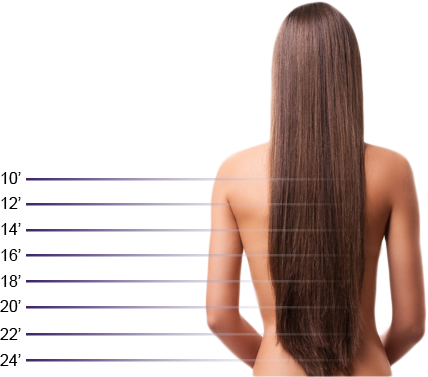About Hair
- Hair lengths
In order to choose the product that you wish for and that perfectly fits, the figure below can help you with your decision. On the picture you can see the hair which is indicated in inches, so you can make up your mind about your desired length. In the diagram on the left of the photo you can see what the associated length in centimeters would be like.


(This figure may differ from reality.)
Currently, there are numerous types of different extensions available on the market which are distinguishable in origin, quality and price etc. If you want to make sure that you spend the right amount of money plus the hair you choose is the correct one, you will have to begin to have a look at the origin, the quality and the extensionssystem of the hair.
- Source of the hair

It is Brazilian hair, Indian hair, Chinese hair, Peruvian hair, European hair and so on. What we are currently seeing the most on the market is Chinese and Indian hair.
Indian hair is mainly sacrificed hair from the Hindu temples in India, while the Chinese hair is collected from factories which they purchased from the countryside.
Indian hair is more stiffened, thicker and dryer of structure. It has a very nice stroke, which varies of a very slight to significant stroke. Chinese hair is softer and finer of structure. For example is 100g Indian hair compared to 100g Chinese hair more content as it is thicker of structure. Also after washing the Indian hair is wavier than when it's dry and therefore more lively. The Chinese hair is usually thick and has a side-like straight/steeper structure.
After you tell the hair-provider what you wish for and what you are looking for, you can choose together with him/her the most appropriate wefts or extensions which matches exactly with your own hair. In general you take the Chinese hair if your hair is straight or has a very lightly stroke, you choose the Indian hair if you want a significant stroke or curly/wavy hair.
- Hair quality
 Virgin hair (untreated) means that the hair is never processed or damaged. In order to qualify it as Virgin hair it has to fulfill specific conditions, namely: it never got permantely dyed, coloured, bleached or chemically processed. This also means that the hair which comes from 1 person still has the undamaged dandruff layer and is smoothly put in the same direction, just as your own hair. This pure form gives the hair a beautiful healthy and lively appearance, what you can clearly see and feel.
Virgin hair (untreated) means that the hair is never processed or damaged. In order to qualify it as Virgin hair it has to fulfill specific conditions, namely: it never got permantely dyed, coloured, bleached or chemically processed. This also means that the hair which comes from 1 person still has the undamaged dandruff layer and is smoothly put in the same direction, just as your own hair. This pure form gives the hair a beautiful healthy and lively appearance, what you can clearly see and feel.
 Remy hair is the hair that has been collected from a hair donor. The epidermis is not trolling and remains in one direction alignment. Remy hair does not stick or knot together because the epidermis is undamaged. The virgin/pure hair has the best quality, even after dyeing it.
Remy hair is the hair that has been collected from a hair donor. The epidermis is not trolling and remains in one direction alignment. Remy hair does not stick or knot together because the epidermis is undamaged. The virgin/pure hair has the best quality, even after dyeing it.
We only can order this sort of hair as Remy hair instead of the pure one. Plus we always advise our customers to take the virgin/pure hair and let it dye in a reliable salon instead of dyeing it in a factory as the hair always gets damaged due to the mass production factory.
100% Human hair (normal human hair/ Non-Remy)
 The most human hair that gets sold in the hairextension industry undergoes multiple treatments, e.g. it is receiving an acid bath. Afterwards there is a silicone layer implemented on the dandruff layer so that it gets an artificial shine and softness again. After a few washings the silicone layer will disappear. The hair will lose its glow and softness directly and it gets tangle free. With Remy sorted hair or virgin hair this is not the case.
The most human hair that gets sold in the hairextension industry undergoes multiple treatments, e.g. it is receiving an acid bath. Afterwards there is a silicone layer implemented on the dandruff layer so that it gets an artificial shine and softness again. After a few washings the silicone layer will disappear. The hair will lose its glow and softness directly and it gets tangle free. With Remy sorted hair or virgin hair this is not the case.
As it is 100% real human hair, you can handle the extensions like you treat your own hair. For example you can easily dye, straighten, curl and wash the hair. Due to the chemical treatments that the hair has undergone while cleaning, it is only possible to dye it from a light to a darker colour, not the other way around.
Comparison chart
| Gestation period before the quality decreases | Dyeable | Curls and Styles |
Virgin haar | 24 - 60 weeks | In every desired colour | V |
Remy haar | 12 - 24 weeks | Just from light to darker | V |
Non-remy haar | 6 - 12 weeks | Just from light to darker | V |
